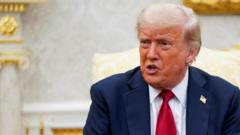In a recent briefing, the White House confirmed that President Trump, aged 79, is dealing with chronic venous insufficiency, a non-serious condition causing leg swelling. While doctors assert it is benign, the condition is prevalent among older adults.
President Trump's Venous Health: Understanding Chronic Venous Insufficiency

President Trump's Venous Health: Understanding Chronic Venous Insufficiency
The White House has disclosed President Donald Trump's diagnosis of chronic venous insufficiency, a common age-related vascular condition affecting blood flow in the legs.
Article text:
During a press briefing on Thursday, Press Secretary Karoline Leavitt announced that President Donald Trump is experiencing a medical condition known as chronic venous insufficiency. The 79-year-old president sought medical attention after observing swelling in his legs, leading to a diagnosis by his doctor during a routine check-up.
Additionally, recent photos of Trump showcasing makeup on the back of his hand have sparked speculation. However, the White House clarified this was due to bruising from frequent handshakes, not linked to his venous condition.
Chronic venous insufficiency (CVI) is characterized as "benign and common," especially among individuals over 70, according to Captain Sean Barbabella, the White House physician, in a statement shared with reporters. This condition arises when the veins in the legs struggle to send blood back to the heart, resulting in pooling in the lower limbs. Aging can lead to weakened vein valves, complicating blood flow against gravity.
The symptoms associated with CVI include leg swelling, as evidenced by Trump's ankles in various images. Dr. Matthew Edwards, chair of the Department of Vascular Surgery at Wake Forest University, points out that while it can be tied to more serious health issues, chronic venous insufficiency itself is generally not dangerous. He estimates that between 10 to 35% of older adults may be affected.
After noting his symptoms, Trump was examined by the White House Medical Unit "out of an abundance of caution," indicated Dr. Barbabella. The comprehensive evaluation confirmed the diagnosis of chronic venous insufficiency, without signs of deep vein thrombosis or arterial disease. Cardiac structure and function tests returned normal results while showing no indications of heart failure or other systemic health concerns. The observation of bruising on Trump’s hand was attributed to minor soft tissue irritation, likely exacerbated by his cardiovascular medication regimen.
According to the Society for Vascular Surgery, CVI can cause discomfort, heaviness in the legs, swelling, and pain. Management strategies may include the use of custom medical-grade compression stockings, leg elevation, and topical lotions to alleviate symptoms.
In April, during his first annual physical of his second presidential term, Dr. Barbabella reported that Trump remains in "excellent health" across various health metrics, including cardiac and neurological function. The assessment led to the disclosure of several medications Trump takes to control cholesterol and prevent cardiac issues. Trump has consistently projected confidence in his health, even labeling himself as "the healthiest president that’s ever lived." After his recent exam, he expressed optimism about his overall well-being, underscoring his belief in his robust health.
During a press briefing on Thursday, Press Secretary Karoline Leavitt announced that President Donald Trump is experiencing a medical condition known as chronic venous insufficiency. The 79-year-old president sought medical attention after observing swelling in his legs, leading to a diagnosis by his doctor during a routine check-up.
Additionally, recent photos of Trump showcasing makeup on the back of his hand have sparked speculation. However, the White House clarified this was due to bruising from frequent handshakes, not linked to his venous condition.
Chronic venous insufficiency (CVI) is characterized as "benign and common," especially among individuals over 70, according to Captain Sean Barbabella, the White House physician, in a statement shared with reporters. This condition arises when the veins in the legs struggle to send blood back to the heart, resulting in pooling in the lower limbs. Aging can lead to weakened vein valves, complicating blood flow against gravity.
The symptoms associated with CVI include leg swelling, as evidenced by Trump's ankles in various images. Dr. Matthew Edwards, chair of the Department of Vascular Surgery at Wake Forest University, points out that while it can be tied to more serious health issues, chronic venous insufficiency itself is generally not dangerous. He estimates that between 10 to 35% of older adults may be affected.
After noting his symptoms, Trump was examined by the White House Medical Unit "out of an abundance of caution," indicated Dr. Barbabella. The comprehensive evaluation confirmed the diagnosis of chronic venous insufficiency, without signs of deep vein thrombosis or arterial disease. Cardiac structure and function tests returned normal results while showing no indications of heart failure or other systemic health concerns. The observation of bruising on Trump’s hand was attributed to minor soft tissue irritation, likely exacerbated by his cardiovascular medication regimen.
According to the Society for Vascular Surgery, CVI can cause discomfort, heaviness in the legs, swelling, and pain. Management strategies may include the use of custom medical-grade compression stockings, leg elevation, and topical lotions to alleviate symptoms.
In April, during his first annual physical of his second presidential term, Dr. Barbabella reported that Trump remains in "excellent health" across various health metrics, including cardiac and neurological function. The assessment led to the disclosure of several medications Trump takes to control cholesterol and prevent cardiac issues. Trump has consistently projected confidence in his health, even labeling himself as "the healthiest president that’s ever lived." After his recent exam, he expressed optimism about his overall well-being, underscoring his belief in his robust health.




















